Sixties
City presents
a wide-ranging series of
articles on all aspects of the Sixties, penned by the creator of the iconic
60s music paper Mersey
Beat
|
Sixties
City presents
a wide-ranging series of
articles on all aspects of the Sixties, penned by the creator of the iconic
60s music paper Mersey
Beat
|
|||||
|
|
A number of the films were based on popular radio shows of the time and
they later began to look into the source material found on television. From
1948 their films included ‘The Man In Black’, ‘Room To Let’, ‘Stolen Face’
and ‘The Lady In the Fog.’ Then, in 1952, they produced two science-fiction
movies which generated an encouraging response. Their first major breakthrough
came when they adapted the highly popular BBC TV ‘Quatermass’ series in
1954 with ‘The Quatermass Xperiment.’ It was a winner, quickly followed by a further box-office success ‘X The Unknown.’ Then they produced the film which was to change their direction entirely and establish them as one of the world’s major production companies and the biggest horror movie specialists since the 30s/40s reign of Universal. The film was ‘The Curse of Frankenstein.’ So many individual ingredients were responsible for the film’s unprecedented success: the timing, coming shortly after a major series called ‘Shock’ on American television which revived Universal’s classic horror movies; the use of colour in the legendary story for the first time; the teaming of Cushing and Lee, and the close-knit team within the Hammer framework itself. All planned schedules were changed following the Frankenstein/Dracula successes. The studio began to specialise in reviving the classic screen horror tales: ‘Dr Jekyll & Mr Hyde’, ‘The Mummy’, ‘The Werewolf’, ‘Sherlock Holmes’, in addition to the continuing Dracula/Frankenstein series. Universal in particular were so impressed that they allowed Hammer to use much of their copyright material, announcing in the summer of 1958 that they would be turning over the copyright of their entire history of horror films for Hammer to remake. All were stamped with a definite Hammer seal because the company, based at tiny Bray on the Thames in Buckinghamshire, had its own key actors, house-trained directors and screenwriters. A major ingredient was the teaming of Cushing and Lee who were to take over the mantle of Boris Karloff and Bela Lugosi as the premier names in the horror genre. |
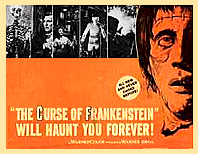 |
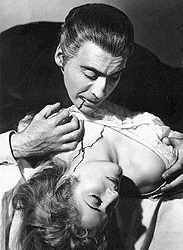 |
Christopher
Lee, born in London in 1922, had made his film debut in ‘Corridor of Mirrors’
in 1947 and appeared in numerous notable British films: ‘Hamlet’, ‘Scott
of the Antarctic’, ‘Captain Horatio Hornblower’, ‘The Crimson Pirate’, ‘Moulin
Rouge’, ‘A Tale Of Two Cities’, but had not really established himself enough
to appear in starring roles because of his above average height of 6ft 5ins.
When he heard that Hammer was seeking an actor to portray the creature in
‘The Curse of Frankenstein’, he applied for the role. “I went along and
actually convinced them that they might make me totally unrecognisable,
because I wasn’t getting anywhere looking like myself.” The appearance as the creature led to his portrayal of Dracula, which made him a star overnight and the natural successor to Bela Lugosi. Hammer was planning to film ‘The Revenge of Dracula’ as the immediate follow-up to ‘Dracula’ but it was cancelled as Lee refused to repeat the role because he was afraid of being typecast. Jimmy Sangster’s script was re-written for ‘Dracula – Prince of Darkness’ in 1965 when Lee agreed to return as Dracula, having appeared in a variety of roles in the meantime. Lee was later to claim that he was the only actor to have portrayed Dracula, Frankenstein’s creature, Fu Manchu, the Mummy and Sherlock Holmes (although Lon Chaney Jr appeared as Dracula, Frankenstein’s creature, the Mummy and the Wolfman) and starred in many Hammer films over the years, including their final horror production, ‘To The Devil A Daughter’ in 1975. Lee became personally very interested in the Dracula legend and was disappointed at the way Hammer failed to develop the character. He appeared as the vampire count for a number of non-Hammer productions, including ‘Bram Stoker’s Count Dracula’; ‘Dracula, Father and Son’ and ‘In Search of Dracula.’ Peter Cushing, born in Surrey in 1913 had also appeared in a number of small film roles, but had built an enviable reputation in television drama and had received the prestigious Television Actor of the Year award, appearing in 23 major productions between 1951-1953, including the controversial ‘1984.’ Cushing asked his agent to apply, on his behalf, for the role of Baron Frankenstein and Hammer, aware of his impressive performance as Winston Smith in ‘1984’, signed him. He became a mainstay of Hammer throughout the Sixties and was to say, “What I liked about those Hammer films such as ‘Dracula’ was that it was all about good and evil – and you had to ensure that good was just as acceptable as bad. They were fairy stories of a kind, I suppose: terror tales which hold messages for all of us deep within their narratives.” The Frankenstein script, by Jimmy Sangster who had worked his way up in Hammer from tea boy to production manager, differed from the Universal approach whose subsequent films followed the adventures of the creature. Sangster placed the accent fully on the Baron, portraying him as a ruthless, but dedicated scientist. Sangster had also set the events of the film in Switzerland at the beginning of the 19th Century – and an attention to a period setting, from costumes to furniture to architecture, became another Hammer hallmark. Cushing commented, “Frankenstein has tremendous style, because he is always the same character. He has perhaps become a little more ruthless, but basically he remains the same. |
|
The actor’s character must always come through to
a certain extent, which makes for some kind of continuity. You also try
to create your character from what the scriptwriter has given you, and I
don’t think that Peter Cushing is all that much like Frankenstein. You are
substantially governed by the script, and the way in which these are written
is bound to reflect current attitudes to some extent.” After Peter had appeared as Baron Von Frankenstein in ‘The Curse of Frankenstein’ (1957); ‘The Revenge of Frankenstein’ (1958); ‘The Evil of Frankenstein’ (1964); ‘Frankenstein Created Woman’ (1967) and ‘Frankenstein Must Be Destroyed’ (1969), Hammer unwisely, and possibly thinking that Cushing was growing too old for the part, cast Ralph Bates in the role for ‘Horror of Frankenstein’ (1970), a remake of ‘The Curse of Frankenstein’, which was a failure and Cushing was recalled for duty in ‘Frankenstein and the Monster From Hell’ (1973). Cushing also provided continuity as Dr Van Helsing in ‘Dracula’ (1958); ‘The Brides of Dracula’ (1960); ‘Dracula A.D. 1972’ (1972) and ’The Satanic Rites of Dracula’ (1973). When making the first ‘Frankenstein’ film, a completely new make-up had to be created for the creature as the Karloff/Pierce monster’s make-up was copyright to Universal. Hammer’s make-up man Phil Leakey devised a scarred, warped skin with greenish-yellow colour and lank black hair. Among his most impressive make-up tasks was the transformation of Oliver Reed into the wolf man in ‘The Curse of the Werewolf’ (1960). Another Hammer make-up man was Roy Ashton. Among the several in-house directors was Terence Fisher, whose first film for Hammer was ‘The Last Page’ (1956). The company chose Fisher to direct ‘the Curse of Frankenstein’ and ‘Dracula’ and he was also involved in several of the sequels and other Hammer horrors such as ‘Hound of the Baskervilles' (1958), ‘The Man Who Could Cheat Death’ (1958), ‘The Mummy’ (1959), ‘Stranglers of Bombay’ (1959), ‘The Two Faces of Dr Jekyll’ (1959), ‘The Phantom of the Opera’ (1962) and ‘The Devil Rides Out’ (1968). Fisher was to say: “Although I was absolutely delighted with the opportunity, I must admit that my being asked to direct the first ‘Frankenstein’ was a stroke of pure luck. It happened that, under the terms of my contract, I was owed a film by Hammer and the next one happened to be ‘Frankenstein.’ “Hammer wanted me to see earlier versions of the Frankenstein story, but I refused to do this because I think everybody should bring his own individual approach to a subject while remaining within the broader confines of the original story. I tried to forget the idea that I was |
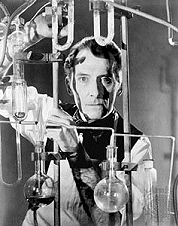 |
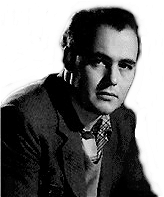 |
Hammer was also noted for its character actors such as Michael Ripper, Miles
Malleson and George Woodbridge, a pool of cameo players who stole many a
scene with their brief appearances as undertakers, jailers, servants, and
drunkards. Another vital ingredient was the glamour. The décolletage of
various actresses such as Hazel Court in ‘The Curse of Frankenstein’, Valerie
Gaunt as the seductive vampire in ‘Dracula’ and various glamorous ladies
who drifted through Hammer films in diaphanous nighties or low-cut dresses:
Ingrid Pitt, Veronica Carlson, Kate O’Mara, Valerie Leon, Martine Beswick,
Susan Denberg and Julie Ege, to name but a few. As the years progressed, due to changing tastes in cinema, Hammer tried to attract audiences by introducing initially naked bosoms, then full-frontal nudity in films such as ‘Twins of Evil’, ‘Lust For A Vampire’ and ‘To The Devil a Daughter.’ One noticeable difference in the use of colour in horror movies was the effect of the gore and James Carreras was to say, “We make three versions of a Dracula film. In the English version we just have the man placing the stake on the heart and that’s it. For America he gives it a couple of sharp taps. But for Japan – and they won’t buy the stuff unless it’s really gory – he hits the stake and the vampire sits up and tries to grab it and he knocks the vampire back and hammers away and blood squirts all over the place and it’s awful.” Once the Dracula and Frankenstein series were underway, Hammer began to remake the Universal horror monster movie themes with ‘The Mummy’ (1959), ‘The Curse of the Werewolf’ (1960), ‘The Two Faces of Dr Jekyll’ (1960) and ‘The Phantom of the Opera’ (1962). There were a number of original horror tales – ‘The Terror of the Tongs’ (1961) and ‘The Gorgon’ (1964); two horror films set in Cornwall ‘The Plague of the Zombies’ (1966) and ‘The Reptile’ (1966) and a series of movies based on Dennis Wheatley novels. Numerous other British studios such as Amicus and Tyburn were now copying the Hammer formula and American investment in British films began to wane. Tastes were also changing and, in an attempt to adapt, Hammer introduced explicit sex into its movies, basing a trilogy of films, the Karnstein trilogy, on the Sheridan Le Fanu story ‘Carmilla’ – ‘The Vampire Lovers’ (1970), ‘Lust For A Vampire’ (1971) and ‘Twins Of Evil’ (1971). |
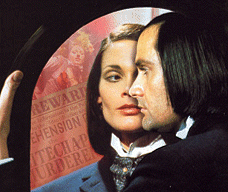 |
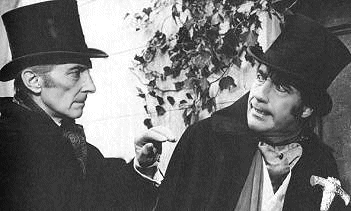 |
"Hammer
supply something that is very much lacking in people’s lives, the element
of fantasy. People love to dream and people love to escape into a dream
world. Hammer films provide those specialised dream worlds. Millions of
people all over the world, when they see the word Hammer, know they will
be entertained. This is the prime business of the cinema”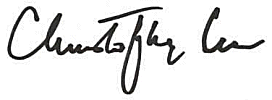 Christopher Lee |
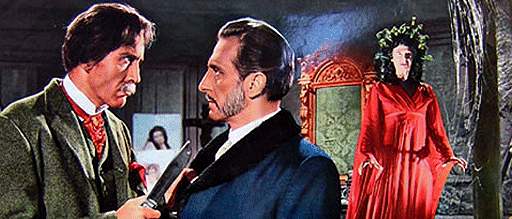 |
| The
Devil Rides Out (1968) First- and best – of the Dennis Wheatley novels to be filmed by Hammer. Christopher Lee, a heroic figure as the Duc de Richleau pitting his knowledge against a coven of devil worshippers led by the warlock Mocata (Charles Gray). The Angel of death, giant spectral spiders and the Devil himself are involved in a tremendous battle between good and evil with a climax in a magic pentacle and a fight on the astral plane. The script was adapted by Richard Matheson. Dracula Has Risen From The Grave (1968) The film that brought Hammer the Queen’s Award for Industry. It takes up the Dracula story where ‘Dracula, Prince of Darkness’ left off. A Monsignor (Rupert Davies) travels to the village of Keinenburg, in the shadow of Dracula’s castle and finds a young girl (Carrie Bauer) murdered, drained of blood, with her body stuffed into a church bell. The villagers no longer attend the church because of its proximity to the castle. The Monsignor is accompanied by the priest (Ewan Hooper) as he climbs to Dracula’s castle to carry out an exorcism and place a huge crucifix outside the castle. In the meantime the priest has fallen and hurt his head and his blood trickles onto the ice into the mouth of Dracula, reviving him. The priest becomes his pawn as Dracula sets off to take revenge on the Monsignor by turning his niece Maria (Veronica Carlson) into a member of the undead. But the Monsignor bars his way with a crucifix and chases the vampire away. He is murdered by the priest and Dracula abducts the girl, but her boyfriend Paul (Barry Andrews) follows him to the castle and as they grapple, Dracula stumbles over a cliff and is impaled on the Monsignor’s golden cross. The Lost Continent (1968) Seeking to extend their repertoire outside the Dracula/Frankenstein/Mummy series, Hammer turned to the world of Dennis Wheatley, Britain’s noted novelist of the occult. The first half of the film places a group of misfits on a tramp steamer, lost in uncharted seas (‘Uncharted Seas’ was the title of the Wheatley novel). Initially, almost a routine lost-at-sea drama with the world-weary Captain Lansen (Eric Porter), falling in love with Eva (Hildegarde Knef), a woman with a mysterious past. Then the entire film changes pace when they sail into a Sargasso Sea, where ancient ships are trapped by carnivorous seaweed. The fleet of ships are inhabited by a strange race, ruled by an evil young king – and travel between vessels is aided by gas filled balloons. The audience hooted when cantilevered Dana Gillespie first appeared, supported by two balloons! Frankenstein Must Be Destroyed (1969) Brain swapping in an asylum: Frankenstein (Cushing) has been corresponding with Dr. Brandt (George Pravda), who has successfully transplanted brains by surgery. When the Baron arrives in Altenburg he discovers Brandt has gone mad and been committed to an asylum. Frankenstein blackmails a young couple (Veronica Carlson/Simon Ward) into helping him kidnap Brandt, but the doctor dies of a heart attack. Frankenstein transplants Brandt’s brain into the head of Professor Richter (Freddie Jones). Brandt regains his sanity but, horror stricken at what has been done to him, vows revenge and traps Frankenstein in a fiery conflagration. Taste The Blood of Dracula (1970) Lord Courtey (Ralph Bates) obtains Dracula’s blood, signet ring, cloak and medallion, intending to revive the vampire in an occult ritual with the aid of three accomplices. During the ceremony they kill him and leave, without realising that his blood, mixed with Dracula’s will bring the Count back from the dead. Dracula vows revenge on all three men through their children and causes Alice (Linda Hayden) to slash her father’s throat with a shovel, Lucy (Isla Blair) to kill her father with a stake and Jeremy to stab his father to death. Alice’s lover Paul (Anthony Corland) traces her to a deserted church where Dracula intends to turn her into a vampire, and uses hymns to revive the power of light in the church to attack Dracula and turn him to dust. |
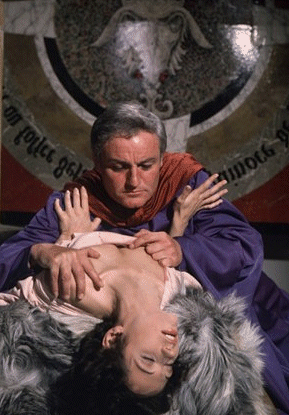 |
|
Article
Text
UK
web hosting by
|